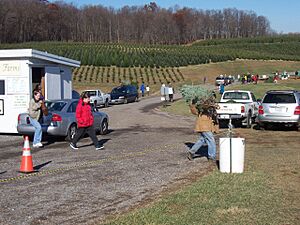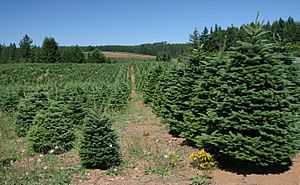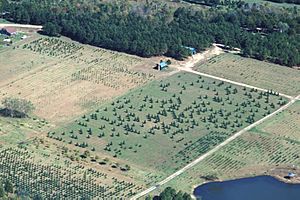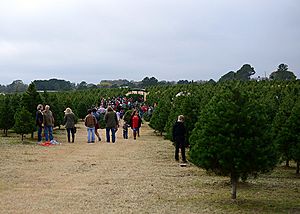Christmas tree production facts for kids
Christmas tree production is all about growing or making the Christmas trees we use during the holidays! These trees can be real, grown on special farms, or artificial, made in factories. Real Christmas trees are usually pine or fir trees. Many countries, like the United States, Germany, and Canada, grow a lot of these trees every year.
People in Great Britain buy about 8 million real trees each year. In the United States, between 35 and 40 million trees are sold during the Christmas season. Most artificial Christmas trees are made in China.
Contents
Growing Natural Christmas Trees
Australia's Tree Farms
Growing Christmas trees is a fairly new type of farming in Australia. The industry there only started in the early 2000s. It's different from farming in the Northern Hemisphere because their seasons are opposite. This means they harvest trees at a different time of year. So, what works for farmers in the U.S. or Europe might not work in Australia.
Also, Australian farmers often grow a tree called Pinus radiata. This type of pine is not as common for Christmas trees in the U.S. and Europe anymore.
European Tree Farms

Europe buys about 50 million real Christmas trees each year. This is more than the 35 million trees bought in the United States. Denmark is a big producer of live Christmas trees. They export about 90% of their trees to other European countries. These include Great Britain, France, Germany, and Austria. In 2004, Denmark sent about 1 million trees to Great Britain. In 2005, Denmark's Christmas tree sales were worth about 1.2 billion kr (about US$204 million). Most of this money came from trees sold to other countries.
The main European countries that grow natural Christmas trees are in central and western Europe. In 2018, Germany grew 18 million trees. France grew 6 million, Denmark 10 million, Belgium 5.2 million, and Great Britain 4.4 million.
Most of the seeds used to grow Christmas trees in Europe come from Georgia. There have been concerns about the working conditions of the people who collect these seeds. Even though European laws protect workers who grow the trees, the seed collectors in Georgia often work in poor conditions.
North American Tree Farms
There are over 20,000 Christmas tree growers in North America. About 95% of the trees they grow are sold directly from the farms. Each year, about 1 million acres (4,000 square kilometers) are planted with Christmas trees. On each acre, there are usually about 2,000 trees. However, only 750 to 1,500 trees survive to be harvested. Christmas trees usually take 6 to 10 years to grow big enough to be cut down. Every year, 73 million new Christmas trees are planted.
North America has three main areas where Christmas trees are grown. These are the Pacific Northwest, the northeast parts of Canada and the United States, and the Appalachian region (like North Carolina). Trees from North America are often considered very high quality in other countries.
In 2002, the United States had 21,904 Christmas tree farms. These farms covered about 447,000 acres (1,800 square kilometers) of land. They cut 20.8 million Christmas trees that year. In 2004, the total value of the U.S. Christmas tree crop was $506 million. Oregon was the top producer, making $143 million. Other big producing states were North Carolina, Washington, and Michigan. In 2012, 24 million trees were sold, worth over $1 billion.
Christmas trees are grown in all 50 U.S. states, even Alaska and Hawaii. For example, Alabama has almost 100 Christmas tree farms. Most of these farms let customers visit and cut down their own tree. In 2002, Pennsylvania had the most Christmas tree farms (2,164). But Oregon had the most land used for growing trees (67,800 acres or 274 square kilometers). Between 2002 and 2012, Christmas tree production dropped a lot in some states, like Kentucky and Wisconsin.
Canada grows about 5 to 6 million of the 40 million live Christmas trees sold in North America each year. In Ontario, most trees sold are Scots pine and White Spruce.
In the 1970s and 1980s, many Christmas trees came from natural forests. But in the 1980s and 1990s, more trees started to be grown on special farms. In 2009 and 2010, about 800,000 Christmas trees were grown in Mexico. Most of Mexico's Christmas tree production happens in the State of Mexico (60%). Trees are also grown in Nuevo León, Veracruz, Mexico City, Puebla, Jalisco, and Guanajuato.
Making Artificial Christmas Trees
Most artificial Christmas trees are made in China. They are often made from 100% recycled plastics, like PVC. People who like artificial trees say they are easy to use, can be used again and again, and look better than older artificial trees. Some apartment buildings even ban real trees because of fire worries.
Poland also has a big market for artificial Christmas trees. About 20% of all Christmas trees sold in Poland are artificial. Many of these are made by families in their homes. For example, in a town called Koziegłówki, many houses make artificial trees. The trees are made from a special film imported from China or Thailand. Whole families work together to make them. These trees are sold all over Poland, and some are even sent to the Czech Republic and Slovakia.
The Christmas Tree Market
European Market Trends
In Great Britain, about 8 million natural Christmas trees are bought each year. But about two-thirds of homes choose artificial trees. In 2006, there was a shortage of trees from Denmark. Only 200,000 Nordmann Fir trees arrived in the British Isles, instead of the usual 1 million. British farmers had to sell more Norway Spruce, Fraser Fir, and Scots pine instead. This shortage happened because of a hot summer and less government help for growing trees in Denmark.
European customers prefer Christmas trees that are less dense and look more open. This is partly because trees are displayed for a shorter time in Europe, and many are lit with candles.
North American Market Trends
The market for natural Christmas trees in the United States faced problems from the late 1980s to the mid-1990s. There were too many trees, which made prices go down. In 1992, Christmas trees in New England sold for about $5 each, instead of the usual $18–30. This was because too many trees (around 850,000) were harvested. The use of natural Christmas trees kept going down over the next ten years. This was partly because artificial trees became more popular. In states where only a few trees were grown, many farmers had to stop their business.
In 1990, over 35 million U.S. homes had natural Christmas trees. But 36.3 million homes chose artificial trees that same year. By 2000, the difference was even bigger: 50.6 million homes used artificial trees, while 32 million chose natural ones. Sales of natural trees continued to drop after 2000. By 2003, only 23.4 million natural trees were sold. From 2003 to 2017, sales of natural trees stayed around 23.4 million each year. During the same time, artificial tree sales went up from 7.3 million to 9.6 million each year.
Historically, U.S. customers liked open, less dense trees, similar to Europeans. But today, U.S. Christmas tree buyers want trees that are more dense. They also start buying trees soon after Thanksgiving. This means trees need to last longer and be harvested earlier.
Mexico needs about 1.8 million Christmas trees each year. Most of these trees are imported. In 2004, the United States supplied 95% of Mexico's imported trees. By 2009, the U.S. still sent almost 1 million trees to Mexico each year. A small number also came from Canada.
Is Christmas Tree Farming Profitable?
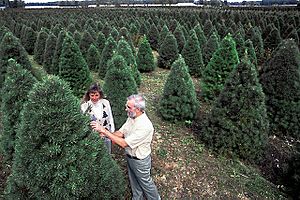
One reason people like Christmas tree farming is that it can be a good way to use land that isn't great for other crops. It can start making money in as little as six years. While there are costs for equipment and workers, you don't need a huge amount of money to start. Each tree can cost farmers $5–10 from the time it's a tiny seedling until it's ready to be cut. This includes land costs and growing costs. In the early 2000s, Christmas tree farmers could earn between $600–1,000 per acre of trees each year.
However, starting a Christmas tree farm does have costs. If you don't own land, you have to buy it, along with equipment. Sometimes, crops fail, which can mean years of work are lost. Besides land, pests, diseases, and bad weather, farmers also have to pay for tractors and other tools for planting, growing, and harvesting. Fences, storage buildings, and rules about worker safety and pesticides also add to the costs of running a Christmas tree farm.
Images for kids
-
This sign at a Christmas tree farm in Seattle shows that most farmers don't price trees by the foot.
See also
 In Spanish: Producción de árboles de navidad para niños
In Spanish: Producción de árboles de navidad para niños


